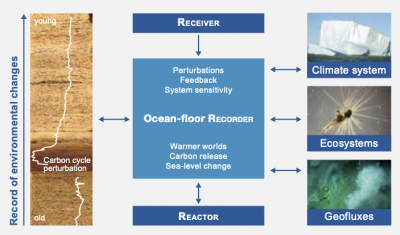- Home
- ...
- The Ocean Floor
- Research Unit RECORDER
- Research Themes
The Ocean Floor
RECORDER Themes and Objectives
Ocean-floor sediments provide a continuous record of environmental and climatic conditions from the Earth’s past. Our objective is to provide the time dimension for processes in the Earth system beyond the limits of the instrumental record, complementing investigations in the Reactor and Receiver Research Units, and to produce records of processes that are not observable on laboratory timescales. We will investigate selected cases of Earth-system behavior under different climatic and geodynamic boundary conditions (e.g., warmer climates, different sea-level stands and plate-tectonic spreading rates).
Our main objectives / expected achievements are:
Using sedimentary sequences covering key intervals of Earthsystem variability at high temporal resolution, research within Recorder will focus on three themes.
- To assess the sensitivity of the Earth System to perturbations we will decipher the physical
and biogeochemical responses to large carbon releases, changes in the hydrological cycle
(incl. monsoon systems), and sea-level variations. - To determine feedbacks between climatic perturbations, water-column processes, and the
ocean floor we will evaluate the controls on temporal variability of the biological pump, the
consequences for carbon cycling in the ocean and carbon deposition at the ocean floor. - To decipher the reactions of marine ecosystems to perturbations we will determine oceanic
ecosystem diversity and function under changing climatic and geodynamic conditions.
An organizational overview of the program is provided in the following table.
| RECORDER | Theme 1 | Theme 2 | Theme 3 |
| Title | Perturbations | Feedbacks | Paleoecosystems and paleobiodiversity |
| Research focus, spatial | Below ocean floor, sedimented | Below ocean floor, sedimented | Below and at ocean floor, primarily sedimented |
| Contributions to overarching objectives (Obj.) of the Cluster | Element fluxes and budgets (Obj. 2); warm-world scenarios (Obj. 4) | Biogenic particle transfer and transformation (Obj. 1); element fluxes and budgets (Obj. 2); warm-world scenarios (Obj. 4) | Biogenic particle transfer and transformation (Obj. 1); ocean-floor ecosystems (Obj. 3) |
| Most important links within the Cluster (T = Theme) |
Emissions at seeps (REACTOR T3), transfer and transformation of sinking particles (REACTOR T1); impact on ocean chemistry and climate (Enabler TECHNOLOGY, Enabler MODELING) | Crust-seawater interactions (REACTOR T3), Earth-system sensitivity, dynamic sea-level in biogeochemical models (Enabler TECHNOLOGY, Enabler MODELING) | Ecological signal modification and transformation in marine sediments (RECEIVER T3); decoding molecular information (Enabler TRACERS) |
| Key study sites | Equatorial Atlantic, Equatorial Pacific, Eastern Equatorial Pacific, NW African margin | Equatorial Atlantic, Pacific, Arctic and Antarctic sea-ice, Greenland margin | NW African margin, Mediterranean |
| Joint study sites | — North Atlantic, NW African margin, Mediterranean — | ||
| Disciplines | Paleoceanography, biogeochemistry | Paleoclimate, paleoceanography, biogeochemistry, organic geochemistry | Marine ecology and paleoecology, paleogenetics, organic geochemistry, marine geology |



